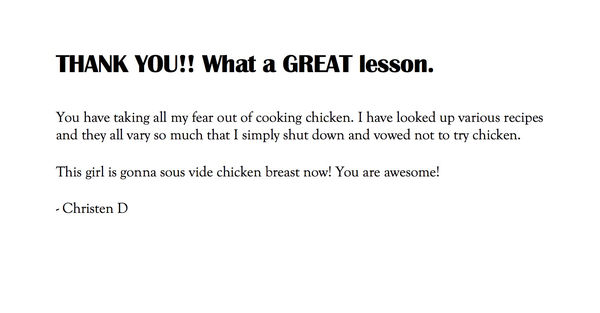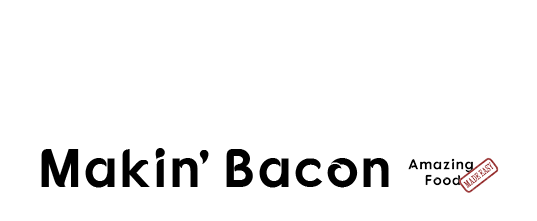
This is part of my Makin' Bacon podcast, you can check out all the episodes or subscribe on your favorite podcast player.
Where Are You Going?
Click to discover how to serve your Fans and grow your incomeLately I've been having conversations with lots of food bloggers who are curious what it takes to "be a successful food blogger". The problem with that question is that it is impossible to answer without knowing what your end goal is.
Listen to or Watch the Interview
This episode from the Makin' Bacon Podcast podcast is available on all your favorite podcast platforms including Apple Podcasts, Spotify, Stitcher, Overcast, and Google Podcasts.
The video of the interview is also available on the Makin' Bacon YouTube Channel.
Asking what makes a "successful food blogger" is like asking "Do I need to pack a sweater?" when you don't know whether you are going skiing in Utah or to the beach in Cancun.
In this article I wanted to talk about a few of the goals you might have as a food professional, and what is important for each one. This is because determining your goals is probably the most critical thing you can do. If you don't know where you are trying to go, it is impossible to figure out the best way to get there.

Content Creator

This is the standard "food blogger" path of old, that worked well for years. Create a lot of recipes, generate a lot of traffic, and make money when the readers click on ads or buy through affiliate links. This will often be supplemented with some sponsored posts.
You can also follow this path on any platform that has ads, such as YouTube.
Strengths
This is the easiest path to get started down. Writing basic recipes is easy, getting some traffic to them is easy, and making some money when people click on ads is easy.
It's also a very complimentary path to most other goals, it can be a steady source of income regardless of what your overall goal is.
Weaknesses
Just because something is easy, doesn't mean it is good.
It may be easy to make a little bit of money and get a little bit of success going down this route, but it is also the hardest to make a good living at.

There is massive competition here - in a survey I ran almost 90% of food bloggers are going exclusively down this track. There are also huge sites focused on it, like Serious Eats, Food52, and Epicurious. You also have to compete with magazines like Milk Street, Bon Appettite, and Saveur as well as with Food Network, BuzzFeed, and Tasty on the video front.
As competition increases, the amount of places brands can advertise also increases, leading to lower ad and affiliate rates.
You are also at the whims of the "algorithms", whether Google, Facebook, Instagram or YouTube. Having all my income dependent on a large company that doesn't care about me is a terrifying prospect.
It is also hard to quickly scale, because to double your income you basically need to double your traffic, which as you know is not an easy prospect.
In general, this is a really crowded, low margin space, where you need to be really vigilant to keep up and succeed.
Major Focuses for Success
Success in this goal is all about traffic, traffic, traffic. Everything you do should be focused on traffic. Creating large amounts of relevant content very quickly is much more important than focusing on really high quality, story-driven content.

Building enough of a brand is important to raise you up in Google results, but not overly critical since you don't care about developing Fans, you want readers that will click on ads.
SEO and keyword research are also critical, as is understanding how you can funnel traffic via Facebook, Pinterest, and other social platforms. Having a strong analytic mindset is a very big strength.
Selling Your Own Products and Services
Selling your own products and services can encompass a wide swath of things. Some examples are writing and selling cookbooks, creating video courses, to making your own kitchen equipment, and selling spices or prepared food.

In this goal, your blog turns into more of a marketing engine, and you can focus on bringing in the right audience and treating them the right way. You need to build up trust with an audience of Fans, create products that meet their needs, and then sell them directly to your Fans.
Bringing in the RIGHT audience is much more important than a LARGE audience.
Strengths
A huge part of this goal is building up trust with your readers and turning them into Fans. These Fans are often willing to buy valuable books, products and courses from you. As long as you keep providing value, they will often continue purchasing new products.

A huge bonus to this path is that you will collect email addresses and contact information for your Fans, making you much less dependent on algorithm changes, new social platforms, and other things out of your control.
You also have a lot of built-in profit in this path. If you create a product or service, you get all of the proceeds from the sale (compared to 5% for many affiliate sales). You can also change the pricing to meet the needs of your audience.
Having a built-in base of Fans can also open up other opportunities with brands who would like to reach them.
The income from selling products and services is also largely passive, meaning you continue to get paid for products you put out in the past, even as you develop new ones (or go on vacation!).

I personally find this path very fulfilling, since I really enjoy getting to know my audience, finding out what they need help with, and then providing them with that help. Most Fans really appreciate it, and you can affect their lives in ways you can't when you are just seeking out traffic.
Weaknesses
The biggest weakness is that you need to come up with products or services that are compelling enough to your audience that they are willing to pay for them. This is almost never just some recipes in a PDF or videos providing content they can find using Google.
This is a larger problem in some niches than others - a blog dedicated to "low cost meals" is going to have a harder time selling products than one dedicated to "cooking gourmet foods", just based off of the demographics of their audience.
It can also be very stressful selling products. You have to invest time, and sometimes money, into something that you aren't 100% sure people will actually want. You have to make yourself more vulnerable, and put yourself out there, much more than in the other goals.

Major Focuses for Success
The key to selling your own products and services is building up an audience that trusts you. It doesn't need to be nearly as big as the Content Creator audience, but you need enough people reading your content that the 5% who buy is large enough to support you.
You also need to connect with your readers, understand their needs, and learn to build products that meet them. Your content will need to be high quality, at least for your specific niche.
Building up your email list is the most important thing you can do with readers, but the platform you connect with them really doesn't matter. A blog is critical to have as a home base, but finding Fans should be more important than just driving traffic to your website.
Working with Brands
There are many, many ways you can work with brands. You may be doing sponsored posts or "influencer work", creating or licensing content and recipes, or consulting with them about social media, the market, or a type of cooking. Getting hired to do demo work, write a cookbook (a publisher is a brand as well), or do a cooking show (either on TV or for a brand's website) also fall under this goal.
If any of those are your goals, it is critical to remember that your audience is the BRANDS, not your readers.
Serving your readers is still important, because brands are looking for people that can connect to Fans and serve their needs, but everything you do should be focused around showing the type of brand you want to work with that you would be a great fit.
Strengths
Brands have money, and they view working with food bloggers and professionals as an investment. If you can consistently show that you can connect with the type of readers the brands are interested in and return their investment in you, then you will be rewarded for it.

It is also easy to scale and build your income through brands, at least to a certain extent. A sponsored post can turn into recipe licensing, then a brand ambassadorship, then bringing you on as a part- or full-time consultant.
Working with brands can also help you grow your own personal brand, leading to more opportunities down the line.
Weaknesses
Most brand work is active, meaning you are trading your time for money. This isn't always bad, but it makes it harder to step away for large chunks of time than some other goals.
This is also a competitive space, but most food bloggers don't focus on it as a goal, and if you do you should position yourself much better than someone that is just writing for their readers.
Not all brands will recognize the value a blogger or food professional can bring to the table, so some education can be required when approaching specific brands.
This goal also requires a decent amount of selling. You'll need to reach out to brands, pitch yourself, and make the case why they should hire you. While not a negative in itself, it can be seen as a negative to many of the more introverted bloggers (like myself!).
Major Focuses for Success

The biggest focus needs to be on figuring out what type of brand you want to work with (food company, equipment company, publisher, tv network, etc.) and how you'd like to work with them. It is pretty easy to determine what they are looking for when hiring people for that role, and you can create content and/or build up an audience to position yourself to meet every one of those needs.
You also need to feel comfortable reaching out and talking to brands. Occasionally one will come to you, but in most cases you need to actively look for them.
It's important to remember that driving traffic to your blog isn't really important to this goal. Understanding the type of audience the brands want, and building that audience on the platform(s) they want is the real key.
You definitely need a website and blog, but if you want to be the face of a brand on YouTube, then building a YouTube audience and portfolio is much more important than spending time driving traffic to your website.
And always keep in mind that you are creating your blog, and building your audience, to impress the type of brand you want to work with.
Supporting a Business
When you are writing your blog to support another business, it is almost entirely used as a marketing engine to attract customers.
There can be some overlap with the above goals, for instance your business might be selling food style services and you want to attract more brands (Working with Brands goal), or you may sell a line of salsa and want to attract customers (Products and Services goal) but the differentiator is most people in this goal view their product or services as their main "job", and the blog as a way to market it.

Strengths
Food blogging is, at it's most basic, a way to bring in readers who want to get certain information. If you are running a business and looking for customers, then a food blog is a great way to find them. Assuming you have a needed, and viable, business that you are running.
Using the blog as a marketing engine removes many of the hurdles from the other goals, because you most likely won't have much competition, you don't need large amounts of traffic, and you already have a product or service that is meeting customer's needs.
Weaknesses
There can be several weaknesses, depending on what your actual business might be, but most of the weaknesses revolve around whether a food blog is the most cost- and time-effective way to attract customers. In many cases it is, and it works great, but you should also explore advertising (Facebook, adwords), partnering with content creators (especially established bloggers!), and other traditional forms of marketing.
If your product or service is a good fit for promoting through a food blog, then there are very few weaknesses involved.
Major Focuses for Success
The key to this strategy is all about doing the upfront market research to understand where your readers are and what type of content they are looking for, and then creating that content for them.
While a website matters, especially as a home base, you should go where your customers are even if that is a platform like Instagram, which is really hard to drive traffic from. Create your content to specifically attract the type of customers you want, and in a way that will put your company in the best light.
What is your overall goal for your food blog and how are you going about accomplishing it?? Let me know in the Makin Bacon Facebook Group or the comments below.
 Hi, I'm Jason Logsdon! I'm an adventurous home cook and the head writer and photographer for Amazing Food Made Easy. I grew my income to 6-figures by focusing on serving my Fans by providing massive value, and I want to help you do the same.
Hi, I'm Jason Logsdon! I'm an adventurous home cook and the head writer and photographer for Amazing Food Made Easy. I grew my income to 6-figures by focusing on serving my Fans by providing massive value, and I want to help you do the same.














